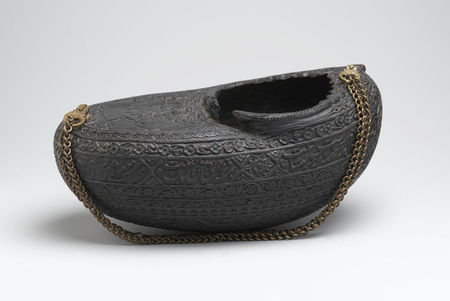'Light of the Sufis: The Mystical Arts of Islam' @ the Museum of Fine Arts, Houston
'Kashkul', or 'Beggar's Bowl', with 'Portrait of Dervishes' and a 'Mounted Falconer', 1880 (A.H. 1280). Coco de mer shell and chain, Brooklyn Museum, Henry L. Batterman Fund, 47.203.5
HOUSTON, TX.- Light of the Sufis: The Mystical Arts of Islam, opening Sunday, May 16, 2010, is the first exhibition at the Museum of Fine Arts, Houston to be devoted to Sufism, a historic branch of Islam whose followers seek mystical union with God. Light of the Sufis travels to Houston from the Brooklyn Museum, where it was organized by the Hagop Kevorkian Curator of Islamic Art, Ladan Akbarnia and originally exhibited in the summer of 2009. The expanded Houston presentation, coordinated by Francesca Leoni, MFAH assistant curator of the Arts of the Islamic World, will include some fifty works of art which are drawn from public and private collections, and will incorporate additional contemporary pieces.
"The MFAH launched the Arts of the Islamic World initiative in 2007 and has since given significant attention to this area, from exhibitions and collection-building to public programming," said Dr. Peter C. Marzio, MFAH director. "We are pleased to further the museum´s efforts to explore and interpret art created in the Islamic world, and Light of the Sufis will introduce the general public to Sufism and to the beautiful works of art inspired by its ideas."
"Although Sufism reached its peak in the medieval and early modern period, it is still practiced today," commented Francesca Leoni. "Light of the Sufis explores some of its facets and driving principles through the lenses of artistic inspiration and production."
Light of the Sufis focuses on some of the most important Sufi ideas and practices that found expression through the arts of the Islamic world, beginning with light, which symbolizes both God and enlightenment. The exhibition features objects that span from the 9th century to the present, and includes furnishings used for mosque lighting; attributes and representations of Sufi mystics; illustrated, illuminated, and laser-etched manuscripts of Sufi poetry; and contemporary works inspired by Sufi principles and practices. Some outstanding objects on view include an early photograph (late 19th-early 20th century) of A Family of Dervishes; a 19th-century Kashkul, or beggar´s bowl, made from coco de mer shell; pages of illuminated calligraphies with Sufi poetry; and an inlaid wine bowl from the late 16th-early 17th century. The exhibition will also include a reading space for visitors who are willing to learn more about Islamic art and the themes in the exhibition. The space will feature reading materials for a variety of age ranges and interests, including books on Islamic art, Sufism, Islam, and poetry.
Sufism
The word Sufism, from the Arabic tasawwuf, is used to define Islamic mysticism. Through a long spiritual path that entails the abandonment of worldly attachments, Sufis aim to achieve mystical union with God (tawhid). The movement grew from early Islamic asceticism, and evolved into a series of movements and organized confraternities (tariqa) lead by spiritual leaders (shaykh or pir). Sufism also absorbed traditions and practices of other faiths and cultures, incorporating elements of Greek philosophies, Christian mysticism, Judaism, Zoroastrianism, Manichaeism, and Buddhism. Sufi-inspired lyrical poetry and literature became one of the principal forms of expression of Sufi ideas and aspirations, part of which eventually found expression in the visual arts.
Wine Bowl. Late 16th—early 17th century. Tinned copper inlaid with black composites. Brooklyn Museum, gift of Mrs. Charles K. Wilkinson in memory of her husband, 1989.149.4
Ali Haravi. Sample of Persian Calligraphy from a Mughal Album. 16th—17th century. Ink, opaque watercolor, and gold on paper. Brooklyn Museum, purchased with funds given by anonymous donors and the Helen Babbott Sanders Fund, 1991.185
Unknown Photographer. A Family of Dervishes. Late 19th—early 20th century. Silver albumen print. Brooklyn Museum, purchase gift of Leona Soudavar in memory of Ahmad Soudavar, 1997.3.139

/https%3A%2F%2Fprofilepics.canalblog.com%2Fprofilepics%2F1%2F0%2F100183.jpg)
/https%3A%2F%2Fstorage.canalblog.com%2F03%2F02%2F119589%2F96711876_o.jpg)
/https%3A%2F%2Fstorage.canalblog.com%2F11%2F31%2F119589%2F94773502_o.jpg)
/https%3A%2F%2Fstorage.canalblog.com%2F20%2F83%2F119589%2F94772815_o.jpg)
/https%3A%2F%2Fstorage.canalblog.com%2F26%2F72%2F119589%2F75604929_o.jpg)
/https%3A%2F%2Fstorage.canalblog.com%2F59%2F60%2F119589%2F26458628_o.jpg)






/http%3A%2F%2Fstorage.canalblog.com%2F24%2F94%2F119589%2F73539341_o.jpg)
/image%2F1371349%2F20240425%2Fob_c453b7_439605604-1657274835042529-47869416345.jpg)
/image%2F1371349%2F20240425%2Fob_59c6f0_440358655-1657722021664477-71089985267.jpg)
/image%2F1371349%2F20240425%2Fob_07a28e_440353390-1657720444997968-29046181244.jpg)